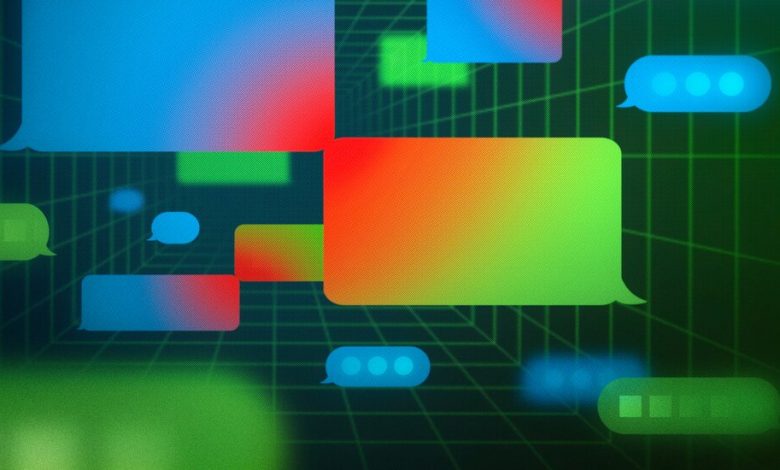Apple Is Doing Its Part to End Green Bubble Shaming. It’s Our Turn.

For more than a decade, smartphone users everywhere have faced a major problem in how we communicate: the “green versus blue bubble” disparity.
When iPhone users send texts to other iPhones, the messages appear blue and can tap into exclusive perks like fun emojis and animations. But if an iPhone user texts an Android user, the bubble turns green, many features break, and photos and videos deteriorate in quality.
Over time, the annoyance and frustration that built up between blue and green bubbles evolved into more than a tech problem. It created a deeper sociological divide between people who judged one another by their phones. The color of a bubble became a symbol that some believe reflects status and wealth, given a perception that only wealthy people buy iPhones.
Now part of this problem will soon be addressed.
This month, Apple announced that it would improve the technology used to send texts between iPhone and Android users, starting next year, by adopting a standard that Google and others integrated into their messaging apps years ago. Texts sent between iPhones and Androids will remain green, but images and videos will look higher-quality and security features like encryption may eventually arrive, Apple said.
But that’s where the good news ends. The bubble culture war is far from over.
On dating apps, green-bubble users are often rejected by the blues. Adults with iPhones have been known to privately snicker to one another when a green bubble taints a group chat. In schools, a green bubble is an invitation for mockery and exclusion by children with iPhones, according to Common Sense Media, a nonprofit that focuses on technology’s impact on families.
“This green-versus-blue issue is a form of cyberbullying,” said Jim Steyer, the chief executive of Common Sense, which works with thousands of schools that have shared stories about tensions among children using messaging apps.
That means it’s now on us to do better and tamp down digital elitism. The solutions, including third-party messaging apps that work consistently between different phones, have been around for years. The rest is about modifying our behavior.
Go Beyond the Defaults
Tech companies are well aware of the power of defaults. Whatever technology comes loaded on a device is what the vast majority of people are likely to use, because it requires the least amount of effort. The reason that we confront the blue-versus-green bubble issue is that we stick to the default texting app that is tied to our phone numbers.
Yet we have options. Third-party messaging apps like WhatsApp and Signal have bridged the gap between iPhones and Androids for years. They link user accounts to phone numbers, which makes contacting people similar to using a standard text-messaging app. These apps also include features like encryption, support for group chats, the ability to send high-resolution photos and videos — and, yes, fun emojis and stickers.
So the next time you exchange numbers with someone on a different phone platform, consider asking the person to keep in touch through an alternate messaging app. This could be a tall order for people who are less technologically inclined, like relatives who barely know how to use their phone. In that case, lend them a hand with setting up their phones. Most Android phones, for example, can be modified to automatically send and receive all messages from a third-party app.
If third-party apps don’t sound appealing, there are other avenues for texting. Plenty of younger people congregate on apps like Discord, Snapchat and Instagram, which have messaging abilities that work consistently between different types of phones.
It comes down to whether you care more about your tech preferences or about your relationships with people, said Irina Raicu, an internet ethics director at the Markkula Center for Applied Ethics at Santa Clara University.
“Smooth and easy means without any friction or any effort, but sometimes you might need to make more effort just because somebody has a different phone than you,” she said. “Relationships require effort.”
Drop the Elitism
In a popular meme on TikTok and YouTube, a man poses a question to random women on the street: “He’s a 10, but he has an Android phone. What’s his new rating?” Most women respond with “1” or “0” and make comments along the lines of “The green bubble, not good — it’s, like, cheap.”
Let’s zoom in on the stereotype. It’s true that Android phones can be more affordable than iPhones because various companies make a wider range of them, including budget models that cost as little as $100. But the top-selling Android phone brand, Samsung, makes flagship Galaxy phones that cost $800 to $1,100, or roughly the same as Apple’s iPhones.
There’s also no evidence that everyone buying iPhones is wealthy. One in five Americans believes that a new iPhone is worth going into debt for, according to a survey by WalletHub, a personal finance research firm.
People choose their phones for various reasons, including features like screen size, camera quality and battery life. While budget may be a factor, a green bubble is not a strong indicator of a person’s income or social status.
Set an Example
In social gatherings, plenty of adults still fuss about the colors of bubbles. When a text conversation turns green, not only do photos and videos look terrible but fun features like adding stickers to messages no longer work properly, and it becomes impossible to leave a group chat. (Messages rendered as green bubbles also lack encryption, an important privacy feature, though this isn’t usually what people fuss about.)
These complaints can influence our children to behave in more negative ways, Mr. Steyer said. For several years, teenagers with Android phones have shared stories about converting to iPhones because they were being left out of iMessage group chats about homework and extracurricular activities.
The onus is on adults to demonstrate to children that many of these tech issues can be addressed — and to remind them that a person’s phone is just a phone, not much more.
Those adults should include the executives of Apple and Google, who have leaned into the bubble war to try to persuade users to join their platforms, Mr. Steyer said.
At a tech conference last year featuring Tim Cook, Apple’s chief executive, an iPhone user in the audience asked whether Apple would make improvements to its messaging app so he could send clearer videos to his mother, who used an Android phone. Mr. Cook flippantly told the questioner to buy his mother an iPhone, a response that many critics deemed elitist.
Apple and Google declined to comment.
“Rise above this — show some maturity here,” Mr. Steyer said. “You don’t want to bully or shame other people over the color of their bubble or the type of their phone.”



